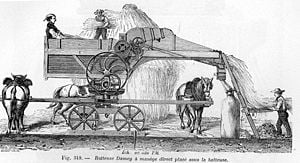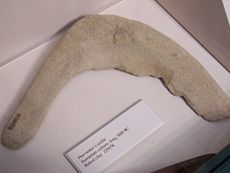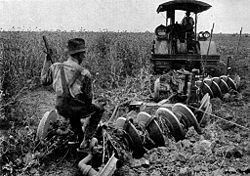History of agriculture
Agriculture has existed for more than 10,000 years.
Origins of agriculture
When major climate change took place after the last ice age c.11,000 B.C.E. much of the earth became subject to long dry seasons. These conditions favoured annual plants which die off in the long dry season, leaving a dormant seed or tuber. These plants tended to put more energy into producing seeds than into woody growth. An abundance of readily storable wild grains and pulses enabled hunter-gatherers in some areas to form the first settled villages at this time.
The practice of agriculture first began around 8000 B.C.E. in the Fertile Crescent of Mesopotamia (part of present day Iraq, Turkey, Syria and Jordan which was then greener). This region was home to the greatest diversity of annual plants and according to one study 32 of the 56 largest grass seeds.
The first crops to be domesticated were all crops of edible seeds, wheat, barley, peas, lentils, chickpeas, bitter vetch and flax. These plants were all readily storable, easy to grow and grew quickly. They had to undergo few genetic changes to be of use to farmers, their wild relatives remaining easily recognisable to this day. Crop domestication took place independently in geographically distant human populations.
In China, rice and millet were domesticated by 7500 B.C.E., followed by the beans mung, soy and aduki. In the Sahel region of Africa local rice and sorghum were domestic by 5000 B.C.E. Local crops were domesticated independently in West Africa and possibly in New Guinea and Ethiopia. Three regions of the Americas independently domesticated corn, squashes, potato and sunflowers.
Humans in many different areas of the earth took up farming in what is, set against the 500,000 year age span of modern humans, a very short time. This is the most convincing evidence that global climate change, and the resultant adaptations by vegetation, were the cause of the beginning of agriculture.
Ancient agriculture
Agriculture is believed to have been developed at multiple times in multiple areas, the earliest of which seems to have been in Southwest Asia. Pinpointing the absolute beginnings of agriculture is problematic because the transition away from purely hunter-gatherer societies, in some areas, began many thousands of years before the invention of writing. Nonetheless, archaeobotanists/paleoethnobotanists have traced the selection and cultivation of specific food plant characteristics, such as a semi-tough rachis and larger seeds, to just after the Younger Dryas (about 9,500 B.C.E.) in the early Holocene in the Levant region of the Fertile Crescent. There is much earlier evidence for use of wild cereals: anthropological and archaeological evidence from sites across Southwest Asia and North Africa indicate use of wild grain (e.g., from the ca. 20,000 B.C.E. site of Ohalo II in Israel, many Natufian sites in the Levant and from sites along the Nile in the 10th millennium B.C.E.). There is even early evidence for planned cultivation and trait selection: grains of rye with domestic traits have been recovered from Epi-Palaeolithic (10,000+ BC) contexts at Abu Hureyra in Syria, but this appears to be a localised phenomenon resulting from cultivation of stands of wild rye, rather than a definitive step towards domestication. It isn't until after 9,500 B.C.E. that the eight so-called founder crops of agriculture appear: first emmer and einkorn wheat, then hulled barley, peas, lentils, bitter vetch, chick peas and flax. These eight crops occur more or less simultaneously on PPNB sites in the Levant, although the consensus is that wheat was the first to be sown and harvested on a significant scale.
By 7000 B.C.E., sowing and harvesting reached Mesopotamia and there, in the super fertile soil just north of the Persian Gulf, Sumerian ingenuity systematized it and scaled it up. By 6000 B.C.E. farming was entrenched on the banks of the Nile River. About this time, agriculture was developed independently in the Far East, probably in China, with rice rather than wheat as the primary crop. Maize was first domesticated, probably from teosinte, in the Americas around 3000-2700 B.C.E., though there is some archaeological evidence of a much older development. The potato, the tomato, the pepper, squash, several varieties of bean, and several other plants were also developed in the New World, as was quite extensive terracing of steep hillsides in much of Andean South America. Agriculture was also independently developed on the island of New Guinea.
The reasons for the development of farming may have included climate change, but possibly there were also social reasons (e.g., accumulation of food surplus for competitive gift-giving as in the Pacific Northwest potlatch culture). Most certainly, there was a gradual transition from hunter-gatherer to agricultural economies after a lengthy period during which some crops were deliberately planted and other foods were gathered in the wild. Although localised climate change is the favoured explanation for the origins of agriculture in the Levant, the fact that farming was 'invented' at least three times elsewhere, and possibly more, suggests that social reasons may have been instrumental.
Full dependency on domestic crops and animals did not occur until the Bronze Age, by which time wild resources contributed a nutritionally insignificant component to the usual diet. If the operative definition of agriculture includes large scale intensive cultivation of land, mono-cropping, organized irrigation, and use of a specialized labour force, the title "inventors of agriculture" would fall to the Sumerians, starting ca. 5,500 B.C.E. Intensive farming allows a much greater density of population than can be supported by hunting and gathering, and allows for the accumulation of excess product for off-season use, or to sell/barter. The ability of farmers to feed large numbers of people whose activities have nothing to do with material production was the crucial factor in the rise of standing armies. Sumerian agriculture supported a substantial territorial expansion, together with much internecine conflict between cities, making them the first empire builders. Not long after, the Egyptians, powered by farming in the fertile Nile valley, achieved a population density from which enough warriors could be drawn for a territorial expansion more than tripling the Sumerian empire in area.[citation needed]
Sumerian Agriculture
In Sumer, barley was the main crop, but wheat, flax, dates, apples, plums, and grapes were grown as well. Mesopotamia was blessed with flooding from the Tigris and Euphrates rivers but floods came in late spring or early summer from snow melting from the Turkish mountains. With Salt deposits under the soil, all of this made Mesopotamia very hard to farm [1]. The earliest known sheep and goats were also domesticated and were in a much large quantity than cattle. Sheep were mainly kept for meat and milk, and butter and cheese were made from it. Ur, a large town that covered about 50 acres (20 hectares), had 10,000 animals kept in sheepfolds and stables and 3,000 slaughtered every year. The city's population of 6,000 included a labour force of 2,500 cultivated 3,000 acres of land. The labour force contained storehouse recorders, work foremen, overseers, and harvest supervisors to supplement labourers. Agricultural produce was given to temple personnel, important people in the community, and small farmers.
The land was plowed by teams of oxen pulling light unwheeled plows and grain was harvested with sickles in the spring. Wagons had solid wheels covered by leather tires kept in position by copper nails and were drawn by oxen and the Syrian onager (now extinct). Animals were harnessed by collars, yokes, and headstalls. They were controlled by reins, and a ring through the nose or upper lip and a strap under the jaw. As many as four animals could pull a wagon at one time. The horse, thought to have been domesticated by nomads in Ukraine in about 4000 B.C.E. was probably domesticated by the Sumerians in 2000 B.C.E.
Aztec agriculture
Further information: Aztec society
The Aztecs were some of the most innovative farmers of the ancient world and farming provided the entire basis of their economy. The land around Lake Texcoco was fertile but not large enough to produce the amount of food needed for the population of their expanding empire. The Aztecs developed irrigation systems, formed terraced hillsides, and fertilized their soil. However, their greatest agricultural technique was the chinampa or artificial islands also known as "floating gardens". These were used to make the swampy areas around the lake suitable for farming. To make chinampas, canals were dug through the marshy islands and shores, then mud was heaped on huge mats made of woven reeds. The mats were anchored by tying them to posts driven into the lake bed and then planting trees at their corners that took root and secured the artificial islands permanently. The Aztecs grew corn, squash, vegetables, and flowers on chinampas.
Roman Agriculture
Roman agriculture built off techniques pioneered by the Sumerians, with a specific emphasis on the cultivation of crops for trade and export.
Agriculture in the Middle Ages
The Middle Ages owe much of its development to advances made in Islamic areas, which flourished culturally and materially while Europe and other Roman and Byzantine administered lands entered an extended period of social and economic stagnation. As early as the ninth century, an essentially modern agricultural system became central to economic life and organization in the Arab caliphates, replacing the largely export driven Roman model. The great cities of the Near East, North Africa and Moorish Spain were supported by elaborate agricultural systems which included extensive irrigation based on knowledge of hydraulic and hydrostatic principles, some of which were continued from Roman times. In later centuries, Persian Muslims began to function as a conduit, transmitting cultural elements, including advanced agricultural techniques, into Turkic lands and western India. The Muslims introduced what was to become an agricultural revolution based on four key areas:
• Development of a sophisticated system of irrigation using machines such as norias (newly invented [citation needed] water raising machines), dams and reservoirs. With such technology they managed to greatly expand the exploitable land area.
• The adoption of a scientific approach [citation needed] to farming enabled them to improve farming techniques derived from the collection and collation of relevant information throughout the whole of the known world[citation needed]. Farming manuals were produced in every corner of the Muslim world detailing where, when and how to plant and grow various crops. Advanced scientific techniques allowed leaders like Ibn al-Baytar to introduce new crops and breeds and strains of livestock into areas where they were previously unknown.
• Incentives based on a new approach to land ownership and labourers' rights, combining the recognition of private ownership and the rewarding of cultivators with a harvest share commensurate with their efforts. Their counterparts in Europe struggled under a feudal system in which they were almost slaves (serfs) with little hope of improving their lot by hard work.
• The introduction of new crops transforming private farming into a new global industry exported everywhere [citation needed]including Europe, where farming was mostly restricted to wheat strains obtained much earlier via central Asia. Spain received what she in turn transmitted to the rest of Europe; many agricultural and fruit-growing processes, together with many new plants, fruit and vegetables. These new crops included sugar cane, rice, citrus fruit, apricots, cotton, artichokes, aubergines, and saffron. Others, previously known, were futher developed. Muslims also brought to that country lemons, oranges, cotton, almonds, figs and sub-tropical crops such as bananas and sugar cane. Several were later exported from Spanish coastal areas to the Spanish colonies in the New World. Also transmitted via Muslim influence, a silk industry flourished, flax was cultivated and linen exported, and esparto grass, which grew wild in the more arid parts, was collected and turned into various articles.
Renaissance to Industrial Revolution
The invention of a three field system of crop rotation during the Middle Ages, and the importation of the Chinese invented moldboard plow, vastly improved agricultural efficiency.
After 1492 the world's agricultural patterns were shuffled in the widespread exchange of plants and animals known as the Columbian Exchange. Crops and animals that were previously only known in the Old World were now transplanted to the New and vice versa. Perhaps most notably, the tomato became a favorite in European cuisine, and maize and potatoes were widely adopted. Other transplanted crops include pineapple, coffee, cocoa, and tobacco. In the other direction, several wheat strains quickly took to western hemisphere soils and became a dietary staple even for native North, Central and South Americans.
Agriculture was a key element in the Atlantic slave trade, Triangular trade, and the expansion by European powers into the Americas. Large plantations producing crops including sugar, cotton, and indigo, were heavily dependent upon slave labor.
By the early 1800s, agricultural practices, particularly careful selection of hardy strains and cultivars, had so improved that yield per land unit was many times that seen in the Middle Ages and before, especially in the largely virgin soils of North and South America.
The 18th and 19th century also saw the development of glasshouses, or greenhouses, initially for the protection and cultivation of exotic plants imported to Europe and North America from the tropics.
Experiments on Plant Hybridization in the late 1800s yielded advances in the understanding of plant genetics, and subsequently, the development of hybrid crops.
Increasing dependence upon monoculture crops lead to famines and food shortages, most notably the Irish Potato Famine (1845–1849).
Recent History
New Technologies
With the rapid rise of mechanization in the late 19th and 20th centuries, particularly in the form of the tractor, farming tasks could be done with a speed and on a scale previously impossible. These advances, joined to science-driven innovations in methods and resources, have led to efficiencies enabling certain modern farms in the United States, Argentina, Israel, Germany and a few other nations to output volumes of high quality produce per land unit at what may be the practical limit.
The development of rail and highway networks and the increasing use of container shipping and refrigeration in developed nations have also been essential to the growth of mechanized agriculture, allowing for the economical long distance shipping of produce.
While chemical fertilizer and pesticides had existed since the 19th century, their use grew significantly in the early twentieth century. In the 1960s, the Green Revolution applied western advances in fertilizer and pesticide use to farms worldwide, with varying success.
Other applications of scientific research since 1950 in agriculture include gene manipulation, and Hydroponics.
New Criticisms
Though the intensive farming practices pioneered and extended in recent history generally led to increased outputs, they have also led to the destruction of farmland, most notably in the dust bowl area of the United States following World War I.
As global population increases, agriculture continues to replace natural ecosystems with monoculture crops, a practice particularly damaging when Slash and burn techniques are employed.
In the past few decades, western consumers have become increasingly aware of, and in some cases critical of, widely used intensive agriculture practices, contributing to a rise in popularity of organic farming.
Agricultural Revolutions
- British Agricultural Revolution
- Green Revolution
- Neolithic Revolution
Credits
New World Encyclopedia writers and editors rewrote and completed the Wikipedia article in accordance with New World Encyclopedia standards. This article abides by terms of the Creative Commons CC-by-sa 3.0 License (CC-by-sa), which may be used and disseminated with proper attribution. Credit is due under the terms of this license that can reference both the New World Encyclopedia contributors and the selfless volunteer contributors of the Wikimedia Foundation. To cite this article click here for a list of acceptable citing formats.The history of earlier contributions by wikipedians is accessible to researchers here:
The history of this article since it was imported to New World Encyclopedia:
Note: Some restrictions may apply to use of individual images which are separately licensed.


